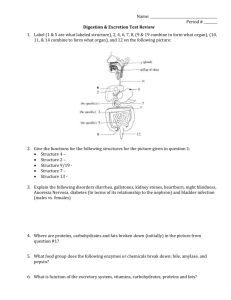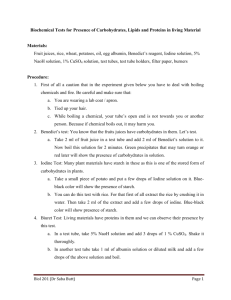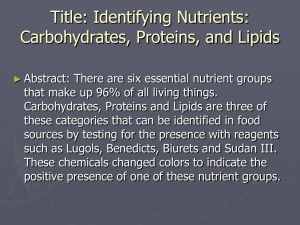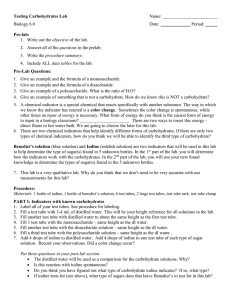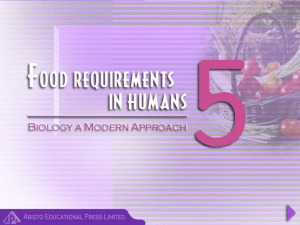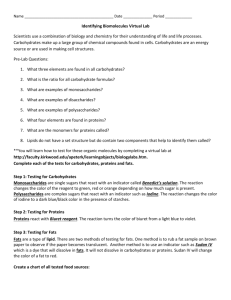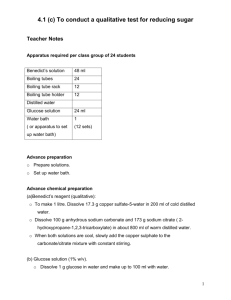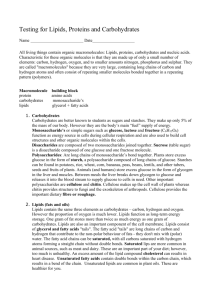here - STAO
advertisement
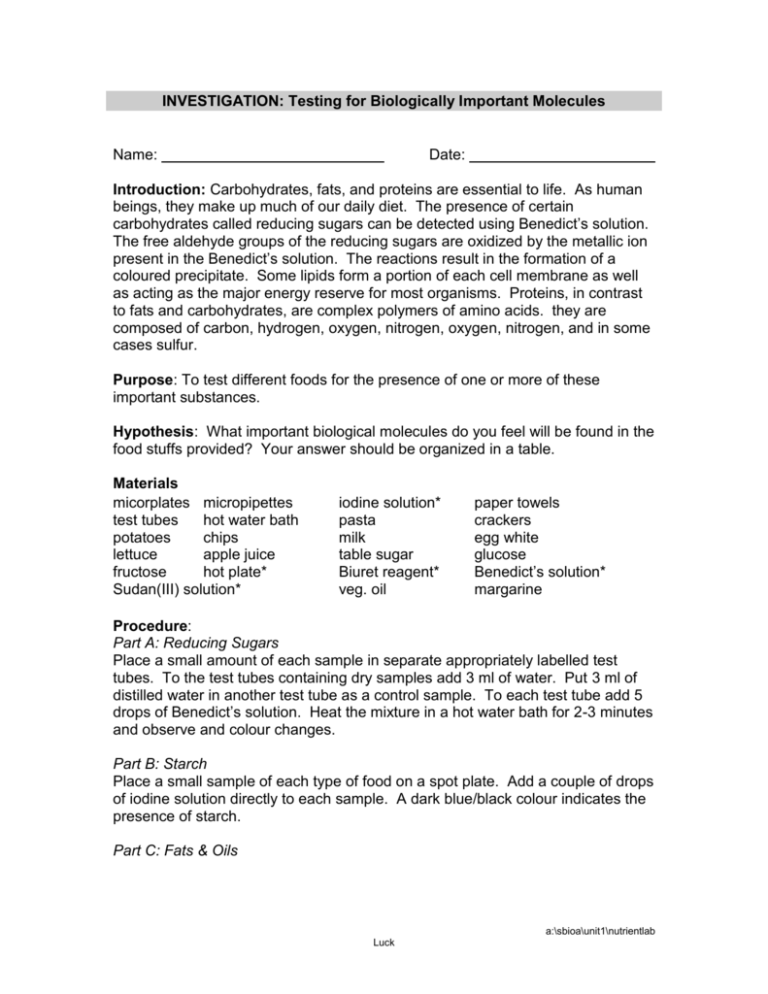
INVESTIGATION: Testing for Biologically Important Molecules Name: Date: Introduction: Carbohydrates, fats, and proteins are essential to life. As human beings, they make up much of our daily diet. The presence of certain carbohydrates called reducing sugars can be detected using Benedict’s solution. The free aldehyde groups of the reducing sugars are oxidized by the metallic ion present in the Benedict’s solution. The reactions result in the formation of a coloured precipitate. Some lipids form a portion of each cell membrane as well as acting as the major energy reserve for most organisms. Proteins, in contrast to fats and carbohydrates, are complex polymers of amino acids. they are composed of carbon, hydrogen, oxygen, nitrogen, oxygen, nitrogen, and in some cases sulfur. Purpose: To test different foods for the presence of one or more of these important substances. Hypothesis: What important biological molecules do you feel will be found in the food stuffs provided? Your answer should be organized in a table. Materials micorplates micropipettes test tubes hot water bath potatoes chips lettuce apple juice fructose hot plate* Sudan(III) solution* iodine solution* pasta milk table sugar Biuret reagent* veg. oil paper towels crackers egg white glucose Benedict’s solution* margarine Procedure: Part A: Reducing Sugars Place a small amount of each sample in separate appropriately labelled test tubes. To the test tubes containing dry samples add 3 ml of water. Put 3 ml of distilled water in another test tube as a control sample. To each test tube add 5 drops of Benedict’s solution. Heat the mixture in a hot water bath for 2-3 minutes and observe and colour changes. Part B: Starch Place a small sample of each type of food on a spot plate. Add a couple of drops of iodine solution directly to each sample. A dark blue/black colour indicates the presence of starch. Part C: Fats & Oils a:\sbioa\unit1\nutrientlab Luck Rub a small sample of each type of food on a piece of paper towel. Hold the paper towel up to the light. A translucent patch on the paper towel indicates the presence of fats and oils. or Place a small amount of each sample in separate appropriately labelled test tubes. To the test tubes containing dry samples add 3 ml of water. Put 3 ml of distilled water in another test tube as a control sample. To each test tube add 5 drops of Sudan (III) solution. Heat the mixture gentyly in a warm water bath for 2-3 minutes and observe and colour changes. Part D: Proteins Add a small sample of each food to different test tubes. Be sure to include an additional test tube containing distilled water to act as a control. Add 6 drops of Biuret’s reagent to each test tube. Warm gently in a water bath. Observations/Experimental Data: Record all observations in a suitable chart. Conclusion/Discussion: Carbohydrates 1. What are the structural differences among the three classes of carbohydrates? 2. What is the structural difference between excess carbohydrates as they are stored in plants and in animals? 3. Explain why Benedict’s solution gives a positive test only with reducing sugars. 4. Explain why the dissaccharide sucrose gives a negative test with Benedict’s solution whereas maltose, also a dissaccharide, gives a positive test. 5. Glucose and fructose combine chemically to produce a molecule of sucrose. How would it be possible to obtain a positive reducing sugar test for sucrose? 6. Why is a distilled water sample necessary in procedures A and B? Lipids 1. Describe the chemical composition of a fat molecule. 2. Compare and contrast the chemical nature of fats, oils, and waxes. 3. Why should a diet including large quantities of saturated fatty acids be avoided? Proteins 1. Explain which of the two is a better test for proteins. 2. Compare and contrast coagulation and denaturation and name several agents involved in these reactions. 3. Describe the functions of proteins. 4. What is a polymer? a:\sbioa\unit1\nutrientlab Luck 5. Explain the two methods of identifying proteins and what each specifically tests for. a:\sbioa\unit1\nutrientlab Luck
